#elearning requirements
Text
IETM for Beginners A Quick Guide to IETM Code and Pixels
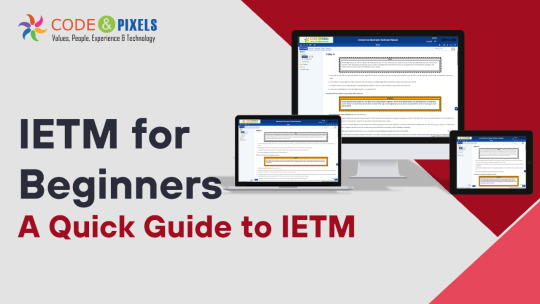
IETM: Interactive Electronic Technical Manual
Training Aids to Defence Client
If you are a supplier of defence then along with the system/equipment you also need to provide Training Aids
(CBT) — Computer-Based Training
Charts and Bloups
Video Film
Training Work Modules
Manuals Hard Copies
IETM
Evolution of Documentation in Defence
Before — Hardcopies and PDFs in DVDs (Upto 2015)
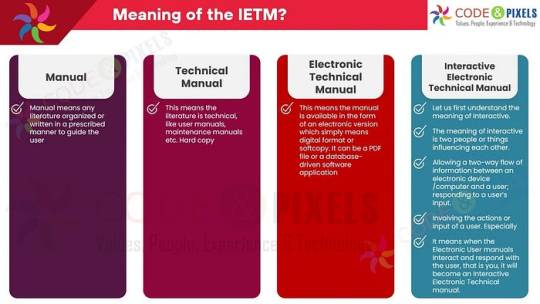
What is the meaning of the IETM?
Manual: Manual means any literature organized or written in a prescribed manner to guide the user.
TechnicalManual: This means the literature is technical, like user manuals, maintenance manuals etc. Hard copy
Electronic Technical Manual: This means the manual is available in the form of an electronic version which simply means digital format or softcopy. It can be a PDF file or a database-driven software application.
Interactive Electronic Technical Manual:
Let us first understand the meaning of Interactive.
The meaning of interactive is two people or things influencing each other.
Allowing a two-way flow of information between an electronic device /computer and a user; responding to a user’s input.
Involving the actions or input of a user. Especially
It means when the Electronic User manuals Interact and respond with the user, that is you, it will become an Interactive Electronic Technical manual.
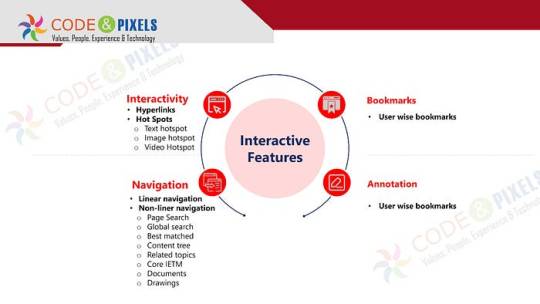
Interactive Features
Interactivity
Hyperlinks
Hot Spots
Text hotspot
Image hotspot
VideHotspot
Bookmarks
User wise bookmarks
Navigation
Linear navigation
Non-liner navigation
Page Search
Global search
Best matched
Content tree
Related topics
Core IETM
Documents
Drawings
Annotation
User wise bookmarks
The documents and pages are many hence, for easy and fast accessibility complete content is converted and stored as a database.
Whenever the user wants some information, IETM software produces the information in a fraction of a second.
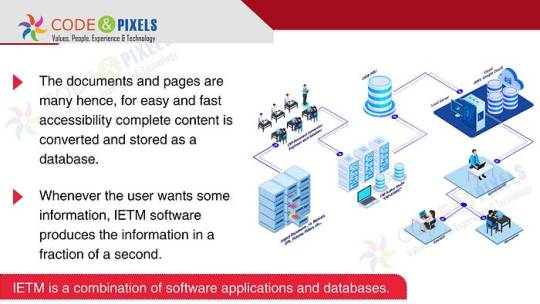
Use or Purpose of the IETM?
The purpose of the Manual is to give information related to the equipment to the end user for quick reference.
All the technicality is written in detail so that when an issue arises, the user can refer to the manual, as every time OEM or technical person or subject matter expert might not be available on the spot to resolve the issue.
If the manual has 10 pages users can refer easily.
But any system used by the defence will have multiple manuals and thousands of page counts and many times a user has to cross-refer between manuals, intra-manual and inter-manual to resolve the issue.
Referring to 10- 15 hard-copy or even soft-copy books simultaneously will be difficult and time-consuming.
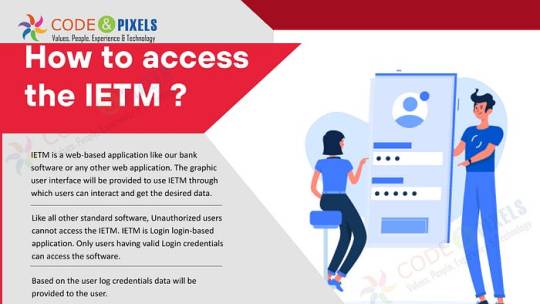
How to access the IETM ?
IETM is a web-based application like our bank software or any other web application. The graphic user interface will be provided to use IETM through which users can interact and get the desired data.
Like all other standard software, Unauthorized users cannot access the IETM. IETM is a Login - login-based application. Only users having valid Login credentials can access the software.
Based on the user log credentials data will be provided to the user.
IETM has 2 types of Users and one Administrator
Maintainer
Operator
If the operator logs in, the user gets all the content related to operator use, similarly if the maintainer logs in only maintenance-related content is visible for that user.
Ideally, all the content is available for both users, because the purpose of the IETM is to refer to the manual to fix the issue.
Administrators can create users who can see the user’s navigation and log-in history and interact with the users using user dashboards through Annotations.
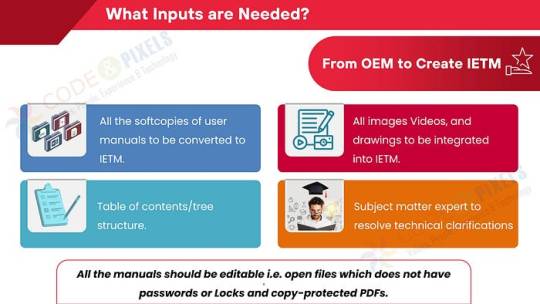
What Inputs are Needed? (From OEM to Create IETM)
All the softcopies of user manuals to be converted to IETM.
All images Videos, and drawings to be integrated into IETM.
Subject matter expert to resolve technical clarifications
Table of contents/tree structure.

Minimum Hardware Requirements?
NO High-end hardware or servers are required to run IETM.
However, if more concurrent users, then a good configuration server with good LAN connectivity must be ensured.
i3 with 8 GB RAM systems is the minimum configuration required for the server or for Node.
Deliverables
BASED DB (Manuals are covered in the Database)
IETM VIEWER Software
User Manual and Installation Manual
Standards — compliance
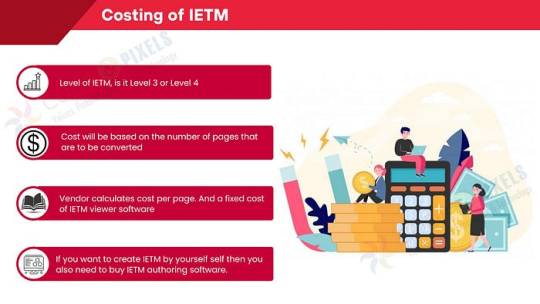
Costing of IETM: (Interactive Electronic Technical Manual)
Level of IETM, is it Level 3 or Level 4
Cost will be based on the number of pages that are to be converted
The vendor calculates the cost per page. And a fixed cost of IETM viewer software
If you want to create IETM by yourself self then you also need to buy IETM authoring software.
What are these Levels?
Level — 1 is any PDF file
Level — 2 is a PDF file with hyperlinks from the table of contents to the body etc.
Level — 3 is an HTML application. More hyperlinks, simple search, a content tree having log a screen with a hardcoded username and password and supplied in the format of EXE so that Windows can easily open
Level — 4 is Software plus Content/manuals converted as Database
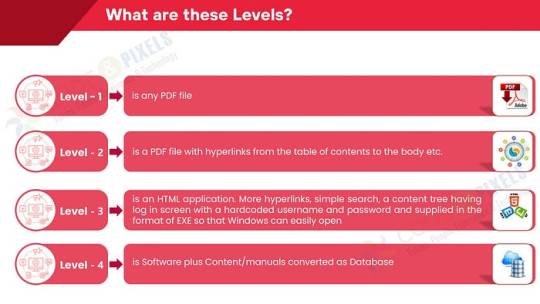
Regarding Level — 5, rest assured, till 2028 it will be Level — 4 only. As of now, there is nothing practically called Level — 5. Few are calling virtual reality and Augmented reality and Artificial intelligence Level — 5.
Pulling data from many user inputs and analyzing and giving results are done in Level — 5. IETM software cannot pull the data from various real-time points as No OEM will give the real-time information to third-party software directly. Yes, if the information is available offline, then that information can be imported into IETM and can be used as a reference.

#ietm#software#technology#ietm developement#ietm code and pixels ietm hyderabad#ietm software#elearning#code and pixels#ietm level iv#codeandpixels#ietm level 4 software requirements#technical documentation#ietm document#ietm documentation#interactive electronic technical manual#Ietm Service Providers#Ietm Software Designers of India#Software Development Company#Elearning Solutions Company#E Learning Content Development Company#Online Education#Digital Education#Digital Content#Software Development Solutions#Elearning#Ietm Developers#Econtent Development#Elearning Solutions Providers#Econtent Developers#Econtent
2 notes
·
View notes
Text

Simazon Unlimited eBooks
Hey everyone,
Something a little different today! I've created a mod to make the Slablet a bit more exciting! Subscribe to Simazon Unlimited and you'll find a big library of eBooks! I've created 60 eBooks, from Classics to current bestsellers, so there's something for every Sim. I created all the covers pretty much from scratch, and they're ALL in Simlish (even though you can't read most of them when it's just a small icon!) Great if you don't have room for a bookcase!
Bookworm and Speedreader Sims will gain more fun than others, and Loner Sims will gain the Social motive from reading. Your Sim will get a buff when they've finished reading their eBook. There are different subscriptions available, and a free trial too, with custom notifications.
This mod also includes a full eLearning Library of Skill books. I may add some other categories if there's enough interest? Maybe childrens books, and separated genres. Let me know what you think! You can send me suggestions using the links here.

⚠️ Please check the attached ReadMe if you have any questions
Required:
💾 XML Injector

PATREON
(early access until 15th May 2024)
#ts4cc#ts4 cc#ts4 mod#ts4 custom content#the sims 4 custom content#thesims4cc#ts4 download#ts4mm#ts4 cc download#the sims 4 mods#the sims 4 download#the sims 4 cc#the sims 4#s4 download#s4 custom content#s4mm#s4 mods
605 notes
·
View notes
Text
Future-Ready School Study Group Learning Spaces
Learning spaces are a brand new concept in the quickly changing educational landscape of today. Rethinking educational settings to promote creativity, cooperation, and invention is now essential as we get ready for the challenges of the future. It is more important than ever to modify learning environments to satisfy the needs of the contemporary world. Moreover, there are many platforms via which you can discover how the synergy of the best school study group transforms traditional classrooms into dynamic hubs of collaborative education.

Since the beginning of time, the conventional classroom arrangement has existed for millennia and hasn’t undergone much modification. However, the modern classroom is undergoing a total metamorphosis due to the rise of technology, shifting demographics, and increasing student demands. The needs of the workforce in the twenty-first century are revolutionizing classroom instruction.
Ensuring the learning success of adolescents requires an understanding of their specific developmental demands. The phases of these learners’ physical, emotional, and social development and transition are well documented by study. By fostering environments that cater to these developmental nuances, the integration of the best kids study group emerges as a powerful tool in providing tailored support and enhancing the educational journey for young learners.
Creating Future-Ready Educational Environments
Many people are concerned that technology may eventually replace human intelligence because it is transforming the world around us so quickly. Some educators fear that, soon, there won’t be any kids left to educate since technology may replace many of the skills and responsibilities that we have been teaching our children for decades. The truth is that education will always exist. It will simply assume new shapes, and the incorporation of the best school study group becomes paramount in navigating these evolving educational landscapes.
To better prepare students for the future, educational environments are being redefined in the following important ways:
1. Diverse Time and Location
More chances for learning at various times and locations will be available to students. Opportunities for self-paced, remote learning are made possible by eLearning tools. Classes will be flipped, meaning that although the practical portion will be taught in person and interactively, the theoretical portion will be learned outside of the classroom.
2. Versatility and Flexibility
To accommodate a range of teaching and learning approaches, contemporary learning environments are made to be both versatile and flexible. These settings, which range from interactive learning zones to cooperative workspaces, promote dynamic engagement and a flexible and adaptable culture.
3. Tailored Education
With study aids that adjust to each student’s ability level, students will learn. This means that after reaching a particular level, above-average pupils will face more difficult assignments and questions. Pupils who struggle in a particular topic will be allowed to practice extra until they achieve the necessary standard, showcasing the adaptability and support offered by the best school study group dynamics.
Continue reading Future-Ready School Study Group Learning Spaces
4 notes
·
View notes
Text
Why Adobe Captivate Should Be Your Next Authoring Tool
Are you looking for a powerful, yet easy-to-use authoring tool to create engaging eLearning content? Adobe Captivate is just what you need.
With Adobe Captivate, you can create video-based tutorials, simulations, and assessments with little to no programming required. Plus, with its built-in themes and templates, you can get started quickly and easily.
5 notes
·
View notes
Video
youtube
Online Training Courses For Employers and Employees
Online learning or Electronic learning (e-Learning or eLearning) is a kind of Technology supported instruction (TSL). The general thought is that as opposed to a coach the understudy learns by utilizing guidance through PC technology.
In certain examples, no up close and personal cooperation happens by any means. E-learning is utilized reciprocally in a wide assortment of settings. In organizations, it alludes to the techniques that utilization the organization to convey training courses to employees. By and large the organization could have a few required courses and furthermore a few intentional courses. The application which trains and tests the employee may be put on the organizations LAN or it could truth be told be provided by an outsider merchant from their site.
In the United States, it is characterized as an arranged educating/learning experience that utilizes a wide range of technologies. Again e-learning's main road is through the Web or all the more explicitly the internet.
Of late e-learning has been utilized to exceptionally incredible impact conveying courses or programs of study where the understudies once in a blue moon, if at any point, go to eye to eye classes. Many universities have carried out broad online learning applications to extend their allure for clients around the world.
The overall e-learning industry is assessed to be worth more than 38 (38) billion euro. Albeit in the European Association just around 20% of e-learning products are produced inside the normal market. Advancements in web and media technologies are the fundamental empowering influence of e-learning, with content. By far most of courses are moved in the IT, Programming and PC skills regions. E-Learning is a trick all term that covers an extensive variety of informative material that can be followed through on a Cd ROM or DVD, over a neighborhood (LAN), or on the Web. However most web clients would probably expect that anything medium they utilize the application serving the course would be upheld by online updates and testing.
By 2006, almost 3.5 million understudies took part in on-line learning. This main includes those in certify third level schooling in the United States. This has now been taken up to an extremely extraordinary degree by employers in the primary world and emerging countries, for example, India where generally speaking there is a legal commitment for employers to train their staff in a few regions. These course may be 'wellbeing and security training based' or they could likewise be 'limitations' based. Governments will generally progressively put the weight of training on the employer who should then supply training to employees. In this setting e-learning has been an extremely incredible time and cash saver according to an employers point of view. Huge employers explicitly can see a profit from their speculation through the employers login to their training community. They can train, set up, timetable and grant confirmation to employees without leaving their seat.
4 notes
·
View notes
Text
Must have features of eLearning apps

eLearning is the process of acquiring knowledge or some additional skill through the use of digital resources and technology. eLearning apps has become an excellent form of providing education since the advent of eLearning, LMS and internet. The technological advancements have undergone a massive change in the education sector over the past few years. Since then, eLearning has proved to be an alternative to traditional classroom education. But most significantly, eLearning has thrived to grow exponentially in the mobile Smart Phone sector as well.
The idea of Learning Management System (LMS) originated around the year 2000, along with eLearning and internet at around the same time. There are three aspects to the idea of LMS viz Learning ie., gain knowledge through courses and training programs, Management ie., organize and manage the course and System ie., a software used for training.
eLearning has introduced a wide range of educational and professional courses with certifications and credits from major universities. Businesses see eLearning as a great way to facilitate upskilling their employees. Students and Professionals are eager to acquire new skills and knowledge, get certifications and advance in their career path.
ELearning app features can vary according to the target organization and the purpose for which it is used in the institution like, eLearning app for schools and colleges, corporate eLearning, training institutes etc., but there are some common features spread across all major platforms. Although there are lot of eLearning platforms offering plenty of courses, still, many companies and training institutes opt to develop their own eLearning courses with provision for customization, setting their own goal and standards, branding, and providing features and functionalities.
Types of eLearning:
a) Synchronous Learning: In this type of learning, classes are held in real time, where the teacher and student can interact and have discussions with each other. Eg. Virtual classrooms sessions with Zoom
b) Asynchronous Learning: In this type of learning, students can access the materials provided in the app at their time of convenience ie., the teacher and student are not present at real time. Eg., video lectures.
Benefits of eLearning:
1) Easily Accessible
2) Cost Effective
3) Faster delivery of knowledge
4) Quick evaluation of performance
5) Increase productivity
6) Reduce the burden on environment like printing books and course material, power consumption and carbon emissions.
7) Diversified Learning
Features you should look for when choosing an eLearning app:
1) Have a separate panel for Administrators, Teachers and Students:
2) Authentication and Authorization: Authentication verifies the identity of a user or service whereas Authorization determines the access rights to the resources.
3) Content Management and delivery: Allows learners to choose their courses and learning paths according to their preference with provision to switch between the courses. The teachers may require managing contents while creating/updating the course. Thus, there is a need to have a proper functionality for file storage, access to resources, sharing the resources etc., Make sure that you infuse micro-learning feature in your eLearning app.
4) Role Management: Training pattern based on the roles and designations of employees in the company with access control features. Every organization has different learning requirement and different group of learners and creating a generalized program will not meet the purpose. Hence, personalization is essential to create organized and specific learning paths.
5) Intuitive User Interface and Dashboard: Enhance Learner interaction and providing summary and analytics on dashboard, and keep track on events on a daily basis. These types of apps makes learning easier and provides various options on podcasts, smart watches, smart phones, tablets etc.,
6) Provision to upload contents: Various documents formats like PowerPoint slides, pdf guides, charts and graphs, podcasts, slideshare, infographics, ebooks etc can be uploaded into the system. It is the duty of the teacher to create and update the course, provide quality and effective online assessments, quizzes, online exams, certifications etc. The students have to upload and submit their coursework assignments within the specified time.
7) Multimedia and Game based Learning: Studies have shown that, games help students learn quickly and retain information longer. Multimedia and game based learning can be an effective way to engage students in your course. Use images, videos, infographics etc to supplement your lessons. AR/VR can be used for gamification and creating unique opportunities for the learners where they develop the right skill set in a virtual environment. Gamification options like leaderboards, ranks, puzzles does help boost learner motivation.
8) Push Notifications: Push notifications are effective remainders to students and teachers where messages are sent periodically on happening of a specific event such as student absenteeism, fees payment, remainder of a new course, assignment, exams etc
9) Query Resolution: Trainees can discuss about course contents, participate in discussions, raise queries and receive solution from the teachers.
10 Mobile Apps: User friendly mobile Apps that support push notification, content sharing, and communication, to deliver eLearning seamlessly.
11. Conduct Live Webinar Sessions: Conduct webinars using Zoom and engage with your learners using polls and other interactive mediums.
12. Tracking and Reporting : Automated customized reporting helps track and monitor learners activities with regard to assignments , attendance, results, certifications etc.,
13) Ecommerce: helps to sell your course material online by providing payment support online by integrated with payment gateways using dedicated API’s.
14) Security: Maintain data integrity and security with SSL and dedicated firewalls.
15) AI and Machine learning for chatbots and content personalization: AI driven personalization creates a customized learning environment for the learners. They allow students to leverage the content and features based on their preference. Students can use a personalized dashboard with recommendations to pursue further courses to continue the learning experience. Machine Learning for chats creates the ability to drive human to human conversations, as the chatbot application is able to learn from the algorithms and the dataset provided by the system and interact with learners, and improve the interactive learning strategy with intuitive content delivery for better learning experience.
16) IoT and Wearable devices: Smartphones, tablets, smart watch, VR headsets can be integrated with eLearning application to create a comprehensive learning experience. With the help of IoT, we can shift beyond the limitations of a mobile application and enhance the learning process.
17) Cloud based LMS (Software-as-a-service (SaaS) LMS): LMS is designed to provide eLearning and enhance efficiency and productivity in training. Its simple interfaces help to create, manage, deliver and track courses online and support a range of features and integration abilities. Reviews performance and gain insight of your training impact with dashboard and reports. Gather feedback from learners, track and manage training completion and access various reports etc., LMS may also be integrated with built in authoring tools which can assist in the teaching process.
18) Social Media integration: Integrating social media tools in your LMS helps in increasing interaction among the learners which can act as a good medium for peer-to-peer discussions and resolving doubts.
The above features make eLearning applications a lucrative business opportunity. Corporate would like to induct all the fresh employees as quick as possible and be familiar with all the work processes. Also, upskilling the existing employees with new skills helps improve overall productive and enhance their skillset. It is difficult to provide training to each and every employee through classroom training. This is where online Course Management System on LMS platform comes in handy. Hence, using a corporate eLearning platform for compliance training helps the learner equip with necessary skills and boost their career and business advancement. Finally, if you would like your eLearning application to stand out and offer value to your learners, keep the above features in mind before you create your application.
URL : https://www.edujournal.com/must-have-features-of-elearning-apps/
#Eleaening#eduJournal#Course#micro-learning#training#LMS#knowledge#upskilling_employees#cost_effective#easily_Accessible
1 note
·
View note
Text
How Do You Deliver eLearning Content?
In an era where digital transformation is reshaping the educational landscape, eLearning has emerged as a pivotal method for delivering training and educational content. The Global Market Insights report reveals that the eLearning market is expected to reach a staggering $375 billion by 2026, underscoring the growing demand for flexible and accessible learning solutions. As organizations and individuals seek effective ways to develop skills and knowledge, understanding how to deliver eLearning content efficiently becomes essential. This article explores the various methods, tools, and strategies employed by eLearning content provider to ensure that learners receive engaging and impactful training.

Understanding the eLearning Landscape
The eLearning ecosystem is diverse, encompassing a wide range of formats and delivery methods. From interactive online courses to mobile learning applications, the options available to eLearning content providers are vast. This flexibility allows businesses to tailor their training solutions to meet specific organizational needs and learner preferences. However, delivering effective eLearning content goes beyond simply providing access; it requires careful planning, implementation, and evaluation.
1. Learning Management Systems (LMS)
One of the most common methods for delivering eLearning content is through a Learning Management System (LMS). An LMS is a software application that enables organizations to create, manage, and deliver online training programs. It provides a centralized platform where learners can access course materials, track their progress, and engage in assessments.
For instance, Infopro Learning, a leading eLearning content provider, utilizes an LMS to deliver customized training solutions for various industries. Their platform allows organizations to host courses, track learner engagement, and analyze performance metrics, ensuring that the training is effective and aligned with business objectives.
2. Virtual Classrooms
Another popular method of delivering eLearning content is through virtual classrooms. These platforms facilitate real-time interaction between instructors and learners, simulating a traditional classroom environment. Virtual classrooms can accommodate large groups and are equipped with features such as video conferencing, screen sharing, and interactive whiteboards.
Infoprolearning offers virtual classroom training as part of its comprehensive suite of eLearning services. This approach allows businesses to conduct live training sessions, enabling learners to ask questions and receive immediate feedback. A case in point is a multinational corporation that utilized virtual classrooms to train its global workforce on compliance regulations. The interactive nature of these sessions led to increased engagement and better knowledge retention among employees.
3. Microlearning
Microlearning is an innovative approach that delivers content in small, digestible chunks, making it easier for learners to absorb information. This method is particularly effective for busy professionals who may have limited time to dedicate to training.
Infoprolearning has successfully implemented microlearning modules that focus on specific skills or knowledge areas, allowing learners to complete training in short bursts. For example, a sales organization could deploy microlearning modules to enhance product knowledge. By breaking down information into concise lessons, employees can quickly access relevant content, reinforcing their learning and improving performance on the job.
4. Mobile Learning
With the increasing prevalence of smartphones and tablets, mobile learning has become a critical component of eLearning delivery. Mobile-friendly content enables learners to access training materials anytime, anywhere, promoting flexibility and convenience.
Infopro Learning recognizes the importance of mobile learning and designs content that is optimized for various devices. A retail company that implemented mobile learning reported a 30% increase in employee training completion rates. The ability to learn on-the-go empowered employees to engage with training during their daily routines, leading to better outcomes and enhanced productivity.
5. Interactive Content
Engagement is a key factor in the effectiveness of eLearning. Interactive content, such as simulations, quizzes, and gamified experiences, can significantly enhance learner engagement and motivation.
Infoprolearning leverages interactive content to create immersive learning experiences. For instance, a financial services firm used simulations to train its employees on customer service scenarios. This hands-on approach allowed learners to practice their skills in a risk-free environment, resulting in improved confidence and performance when dealing with real customers.
6. Blended Learning
Blended learning combines traditional face-to-face training with online eLearning components. This approach allows organizations to leverage the benefits of both methods, providing a comprehensive learning experience.
Infopro Learning adopts a blended learning model by integrating online courses with in-person workshops. For example, a healthcare organization might utilize online modules to provide foundational knowledge while reserving in-person sessions for hands-on training. This hybrid model ensures that learners receive a well-rounded education, enhancing their skills and knowledge retention.
Real-World Examples
Several organizations have successfully implemented eLearning content delivery strategies to enhance their training initiatives.
Cisco: The technology giant transformed its training approach by adopting an LMS that offered a range of eLearning modules. As a result, Cisco reported a 25% increase in employee engagement and a significant reduction in training costs.
Deloitte: Deloitte’s Leadership Academy utilized virtual classrooms and interactive content to deliver leadership training to its global workforce. The program resulted in improved leadership capabilities across the organization, showcasing the effectiveness of well-structured eLearning solutions.
The Importance of Evaluation and Feedback
Delivering eLearning content is not a one-time effort; it requires ongoing evaluation and feedback to ensure its effectiveness. Organizations should regularly assess learner progress and gather feedback to refine their training programs. This iterative process allows eLearning content providers to make data-driven decisions, continuously improving the quality of their offerings.
Utilizing analytics tools within an LMS can provide insights into learner engagement, completion rates, and knowledge retention. For instance, organizations can track how learners interact with specific modules and identify areas where additional support may be needed. By acting on this data, businesses can enhance their training initiatives and drive better outcomes.
Actionable Advice for Businesses
To successfully deliver eLearning content, businesses should consider the following actionable steps:
Define Clear Objectives: Establish specific training goals aligned with organizational objectives. This clarity will guide the selection of delivery methods and content.
Choose the Right eLearning Content Provider: Partner with an experienced eLearning content provider like Infoprolearning to ensure high-quality, engaging training solutions tailored to your needs.
Leverage Technology: Utilize modern technology, such as LMS platforms and mobile learning, to create flexible and accessible training programs.
Incorporate Interactivity: Enhance engagement by integrating interactive content, such as simulations and gamification, into your training modules.
Monitor and Evaluate: Regularly assess learner progress and gather feedback to refine training programs and improve outcomes.
Foster a Learning Culture: Encourage a culture of continuous learning within the organization, promoting the value of eLearning and professional development.
Conclusion
Delivering effective eLearning content is a multifaceted process that requires careful planning, implementation, and evaluation. By leveraging various delivery methods, engaging content, and advanced technology, businesses can create impactful training programs that foster growth and development. As the demand for eLearning continues to rise, partnering with a credible eLearning content provider like Infoprolearning can help organizations navigate the complexities of digital training, ensuring their workforce is well-equipped to meet the challenges of the future.
#elearning development services#elearning content developer#elearning content provider#top elearning content provider
0 notes
Text
Revolutionize eLearning with Coursebox’s AI-Powered Course Creation Platform

Coursebox is an advanced AI-driven eLearning platform designed to streamline the creation, management, and delivery of online courses. It offers a comprehensive suite of tools including AI course authoring, automated assessments, and real-time AI tutoring, all aimed at enhancing the learning experience. Whether you’re an educator, training provider, or business, Coursebox enables you to create engaging, scalable eLearning content quickly and efficiently.
Main Content:
Core Functionality: AI-powered course creation, automated grading, and real-time tutoring.
Key Features:
AI Course Designer: Automatically generate course structures and content.
AI Quiz Generator: Create quizzes and assessments in seconds.
Real-Time AI Tutor: Provide instant support to learners based on course content.
Benefits:
Efficiency: Significantly reduce the time and effort required for course creation.
Engagement: Enhance learner engagement with personalized support and instant feedback.
Scalability: Easily scale your training business by automating course development and management.
Transform your eLearning offerings with Coursebox.
Visit https://aiwikiweb.com/product/coursebox-ai/
0 notes
Text
Empowering Your Workforce: A Guide to Enterprise LMS Solutions
Enterprise lms: In today's rapidly evolving business landscape, employee training is no longer a luxury - it's a necessity. A skilled and knowledgeable workforce is the backbone of any successful organization. But with geographically dispersed teams, complex compliance requirements, and an ever-growing knowledge base, traditional training methods can quickly become outdated and inefficient.

This is where Enterprise Learning Management Systems (LMS) come in. An enterprise LMS is a powerful software platform designed to streamline and centralize the entire employee learning and development process. Edz LMS, for example, offers a comprehensive solution specifically tailored for the needs of large organizations.
Why Choose an Enterprise LMS for Your Business?
There are numerous benefits associated with implementing an enterprise LMS. Here are just a few key advantages:
Scalability and Accessibility: An enterprise LMS can easily manage a large number of learners, geographically dispersed teams, and diverse training needs. Learners gain 24/7 access to training materials, allowing them to learn at their own pace and convenience.
Centralized Content Management: Eliminate the hassle of scattered training materials! An enterprise LMS allows you to create, store, and manage all your training content in one secure, central location. This ensures consistency and accessibility for all employees.
Improved Compliance Training: Ensure your workforce remains compliant with industry regulations and internal policies. An enterprise LMS facilitates the creation, delivery, and tracking of compliance training courses, allowing you to generate detailed reports and demonstrate adherence to regulatory requirements.
Reduced Training Costs: Replacing instructor-led training with online learning modules can significantly reduce overall training costs. Additionally, an enterprise LMS simplifies course administration and provides valuable data insights to guide future training initiatives.
Enhanced Learning Engagement: Modern enterprise LMS platforms offer a variety of engaging features, including interactive assessments, gamification elements, and social learning communities. This fosters a more engaging learning experience and improves knowledge retention.
Edz LMS understands the unique needs of large organizations. Our platform offers a robust set of features specifically designed to empower your workforce and optimize your training ROI.
Key Features of Edz LMS for Enterprise Learning
User-Friendly Interface: Edz LMS provides an intuitive and user-friendly interface for both learners and administrators. This ensures smooth adoption and minimizes the need for extensive training.
Course Authoring Tools: Create and deliver engaging eLearning courses with ease using Edz LMS's built-in authoring tools. No coding experience is required!
Multi-format Learning Content: Support a variety of learning styles and preferences by incorporating multimedia elements like videos, audio, images, and simulations into your training modules.
Learning Paths and Customization: Edz LMS allows you to create personalized learning paths for different roles and departments. This ensures targeted and relevant training for each learner.
Learning Analytics and Reporting: Gain valuable insights into learner progress, knowledge retention, and overall program effectiveness with detailed reports and analytics dashboards.
Mobile Learning: Edz LMS is fully responsive and accessible on any device, including mobile phones and tablets. This empowers learners to access training materials and complete courses on-the-go.
Integrate Learning into Your Enterprise Culture
An effective enterprise LMS doesn't just provide training; it becomes an integral part of your organization's learning culture. Edz LMS fosters a collaborative learning environment through discussion forums, social learning tools, and gamification elements. Learners can share knowledge, ask questions, and support each other in their professional development journeys.
Ready to Take Your Training to the Next Level?
Edz LMS offers a comprehensive and scalable solution to meet the needs of your growing enterprise. Contact us today to schedule a demo and discover how our platform can help you empower your workforce and achieve your business goals!
Contact Us:
Head Office: Bengaluru, Karnataka
Email: [email protected]
Phone: +91 – 9916662080
Schedule a Demo: https://calendly.com/edzlms/30min
Read our Recent Blogs: https://edzlms.com/blogs/
Download our Recent Case Study: https://edzlms.com/case-study/
By implementing a robust enterprise LMS like Edz LMS, you can unlock the full potential of your workforce and drive business success through effective and engaging employee training.
0 notes
Text
What are these Levels -Code and Pixels IETM
Code and Pixels Interactive Technologies Private Limited (CNP) is an IT service provider based in Hyderabad (India). We provide end-to-end eLearning solutions and IETM development (INDIAN STANDARD IETM JSG 0852:2001, LEVELS 3,4,5 and European Aviation Standard IETM Level4 ), specialized in innovative use of technology.

#ietm level 4 software requirements#technical documentation#ietm developement#ietm document#ietm documentation#interactive electronic technical manual#Ietm Service Providers#Ietm Software Designers of India#Software Development Company#Elearning Solutions Company#E Learning Content Development Company#Online Education#Digital Education#Digital Content#Software Development Solutions#Elearning#Ietm Developers#Econtent Development#Elearning Solutions Providers#Econtent Developers#Econtent#Mobile Learning#What is Html5#Software Solutions#Software Development & E-learning Solutions
1 note
·
View note
Text
Custom eLearning Solutions for Effective Learning and Development
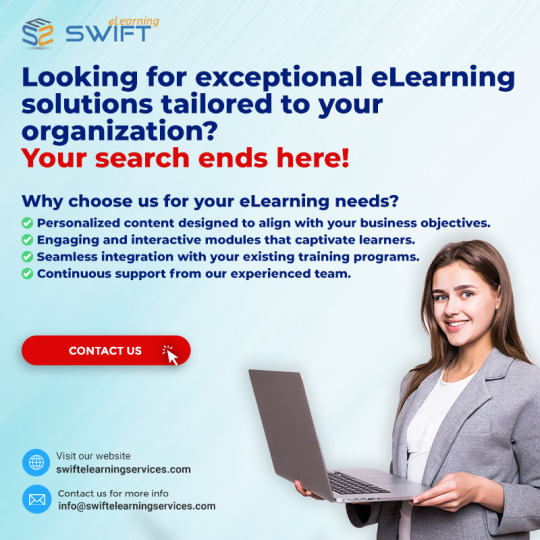
Custom eLearning solutions design interactive, engaging courses tailored to meet your specific training needs at competitive prices.
Our eLearning Solutions:
Rapid eLearning
Blended Learning
Legacy Content Conversion
Translation & Localization
Learning Management System (LMS)
Human Resource Management System (HRMS)
What is Custom eLearning?
Custom eLearning provides personalized online courses that cater to the unique needs of learners and organizations. Our goal is to enhance training effectiveness and maximize return on investment (ROI).
The transition from ILT/VILT to eLearning: Convert classroom-based training into SCORM and HTML5 content for interactive, accessible learning.
Microlearning Solutions: Bite-sized modules designed for on-the-go learning to improve quick knowledge retention.
Game-Based Learning Solutions: Engage learners through interactive, game-based learning strategies for effective knowledge transfer.
eLearning Content Development
We offer tailored learning experiences designed to meet specific objectives and learner needs.
Rapid eLearning: Quick, efficient course development using rapid authoring tools.
Blended Learning: Seamlessly integrates in-person and online learning for a balanced training approach.
Custom eLearning Samples
Explore our diverse range of custom eLearning solutions that enhance employee skills through interactive modules and simulations.
Content Conversion Solutions
Legacy Content Conversion: Modernize outdated materials into digital formats.
Flash to HTML5: Upgrade Flash-based courses for compatibility with modern standards.
PPT to eLearning: Turn PowerPoint presentations into engaging eLearning content.
ILT to eLearning Conversion: Transform traditional training materials into dynamic eLearning courses.
Translation & Localization Solutions
Our translation services convert eLearning content into various languages, while localization adapts it to fit specific cultural contexts.
eLearning Translation Services: Convert text, images, audio, and video for multilingual learners.
Multimedia Localization: Adapt multimedia elements like graphics, animations, and more for different audiences.
Our Approach
Storyboarding: Visualizing the course structure for better clarity.
Multimedia-Rich Content: Enhance engagement with videos, animations, and infographics.
Personalization: Tailored learning experiences to match individual needs.
Scenario-Based & Gamified Learning: Real-life challenges and gamification drive deeper understanding and motivation.
Compliances and Standards
We ensure compatibility with eLearning standards such as SCORM, xAPI, and HTML5, as well as mobile responsiveness across devices. We also utilize cutting-edge technologies like AI, VR, and AR to enhance learner engagement.
Custom vs. Off-the-Shelf eLearning
Custom eLearning: Tailored to your specific organizational needs, goals, and brand identity.
Off-the-Shelf Courses: Standardized solutions for quick deployment and cost-efficiency.
Elevate Your Training
We specialize in training for:
Onboarding
Safety & Compliance
Sales & Product Knowledge
Leadership & Soft Skills
Industries We Serve
Our eLearning solutions cater to diverse industries, including corporate organizations, educational institutions, healthcare, and government.
eLearning Authoring Tools
We use industry-leading tools like Articulate Storyline, Adobe Captivate, and Camtasia to deliver high-quality, custom eLearning content.
What Our Clients Say
“Swift provided excellent support in developing our online course. Delivered on time and within budget, the course is now widely used and highly effective.”— Mark Cozens, Principal Veterinary Officer
Please send us your requirements at:[email protected]://www.swiftelearningservices.com/contact-us/
FAQs
Why choose custom eLearning?
Custom eLearning offers flexibility, and enhanced engagement, and aligns closely with your goals.
What does it cost?
Costs typically range from $2000 to $8000, depending on the complexity and customization required.
How long does it take?
Custom eLearning content development generally takes 3 to 5 weeks per hour of content.
Can you customize eLearning content to reflect our brand?
Yes, we tailor all content to align with your company’s branding and values for a consistent learning experience.
#custom eLearning solutions#customs eLearning#custom eLearning development#eLearning development#custom eLearning content#bespoke eLearning#custom eLearning services#custom eLearning content development#custom eLearning design#customized eLearning#eLearning solutions
1 note
·
View note
Text
How Aptara Corp’s Custom Content Development Transforms Corporate eLearning
In the ever-evolving landscape of corporate training, the need for effective and tailored eLearning solutions has never been greater. Aptara Corp stands out as a leading provider in this field, specializing in custom content development that transforms corporate eLearning environments. This article explores how Aptara’s corporate elearning solutions and training content development services can significantly enhance organizational productivity and learning.
1. The Role of Custom Content Development
Custom content development is pivotal in creating training programs that align with an organization’s specific needs and objectives. Unlike generic eLearning solutions, custom content is designed to address particular challenges faced by a company, making the training more relevant and engaging for employees. Aptara Corp excels in this area by providing bespoke solutions that cater to the unique demands of its clients, ensuring that every piece of content is both meaningful and impactful.
2. Aptara Corp’s Expertise in Corporate eLearning Solutions
As one of the top corporate elearning solutions providers, Aptara Corp leverages its extensive expertise to deliver high-quality, tailored training content. Their approach involves a detailed understanding of the client’s requirements, including industry-specific needs and organizational goals. This allows Aptara to create custom content development solutions that not only meet but exceed expectations. Their focus on creating engaging and interactive eLearning content ensures that employees are more likely to retain and apply the knowledge gained during training.
3. Enhancing Learning with Custom Content
The effectiveness of training content development lies in its ability to engage learners and facilitate a deeper understanding of the material. Aptara Corp’s custom content development services include a variety of interactive elements, such as simulations, gamification, and multimedia components, designed to cater to different learning styles. This innovative approach not only makes learning more enjoyable but also enhances information retention and application in real-world scenarios.
4. Impact on Organizational Productivity
Effective eLearning solutions can significantly impact organizational productivity. By providing employees with relevant and engaging training, companies can expect to see improvements in performance, efficiency, and overall job satisfaction. Aptara Corp’s corporate elearning solutions are designed to deliver measurable results, helping organizations achieve their training objectives while driving business growth. The custom content developed by Aptara ensures that training programs are directly aligned with business goals, leading to a more productive and knowledgeable workforce.
5. Success Stories and Real-World Applications
Aptara Corp has a proven track record of transforming corporate eLearning through its custom content development services. The company’s ability to design and implement tailored training solutions has led to numerous success stories across various industries. By partnering with Aptara, organizations have successfully enhanced their training programs, resulting in increased employee engagement, better learning outcomes, and improved organizational performance.
6. Conclusion
In conclusion, custom content development is a crucial element in transforming corporate eLearning. Aptara Corp’s expertise in corporate elearning solutions and training content development ensures that organizations receive high-quality, tailored content that enhances learning and boosts productivity. For businesses seeking to elevate their training programs and achieve significant improvements in employee performance, Aptara offers the innovative solutions needed to make a lasting impact.Know More About - Why Custom Learning Solutions are Vital for Corporate Training Success: Aptara Corp’s Approach
0 notes
Text
https://www.sifytechnologies.com/digital-services/digital-xr/digital-learning/
Sify's Digital Learning Solutions: Empowering Learning in the Digital Age

In today’s fast-paced digital era, the need for dynamic and adaptable learning solutions has never been greater. Sify’s Digital Learning Solutions offer cutting-edge, customized approaches that drive employee engagement, skill development, and corporate growth. Tailored for businesses and educational institutions, Sify’s digital learning platforms blend innovation with expertise to ensure that learning is engaging, efficient, and scalable.
Why Digital Learning Matters Today
As organizations pivot towards digital transformation, learning methods must evolve to meet the growing demands of a tech-savvy workforce. Traditional learning models, often slow and inflexible, are being replaced by digital platforms that provide real-time access, interactive features, and analytics-driven insights. Sify's Digital Learning Solutions bridge this gap by offering an immersive, interactive, and personalized learning experience.
Sify’s Approach to Digital Learning
Sify is a leader in providing end-to-end digital learning solutions that align with the specific needs of businesses. Whether it’s skill development, corporate training, or onboarding processes, Sify leverages advanced technologies and modern methodologies to foster continuous learning.
Key features include:
Custom Learning Solutions: Each solution is designed based on the unique requirements of the organization, ensuring relevance and targeted impact.
Mobile and Cloud-Based Learning: Accessible across devices and locations, enabling employees to learn anytime, anywhere.
Interactive and Immersive Experiences: With tools like gamification, simulations, and virtual labs, Sify makes learning fun, interactive, and practical.
Learning Management Systems (LMS): A scalable, secure platform that offers integrated content delivery, tracking, and reporting.
Core Services and Offerings
eLearning Modules
Sify offers a wide range of customizable eLearning modules designed to meet industry-specific learning needs. These modules cover areas such as compliance, soft skills, technical training, and leadership development.
Virtual Instructor-Led Training (VILT)
Combining the traditional classroom with digital tools, Sify provides VILT solutions to foster real-time collaboration and communication. This ensures active engagement, making the learning process interactive and practical.
Microlearning
Microlearning solutions are focused on delivering short, targeted learning segments. This is ideal for busy professionals who need quick, digestible insights on-demand.
Gamification and Simulations
Sify integrates gamification techniques and virtual simulations into its digital learning platforms, enabling learners to engage in competitive and real-world scenarios. This leads to a higher retention rate and improved understanding.
Content Creation and Curation
Sify’s experts assist in creating unique learning content that fits the organization’s brand, goals, and culture. Content is developed using the latest instructional design practices and is regularly updated to stay relevant.
The Benefits of Sify’s Digital Learning Solutions
Personalized Learning Paths: Tailored learning experiences that cater to individual strengths and development areas.
Increased Engagement: Interactive features like quizzes, gamification, and discussion forums keep learners engaged.
Scalability: Whether you're a small organization or a global enterprise, Sify’s platforms grow with your business.
Cost Efficiency: Digital learning reduces the costs associated with traditional classroom-based training, travel, and printed materials.
Analytics and Reporting: Comprehensive insights and data to measure progress, participation, and the effectiveness of learning programs.
Industries Benefiting from Sify’s Digital Learning Solutions
Sify’s digital learning platforms have transformed industries across the board, from IT and technology, to healthcare, manufacturing, finance, and retail. Each sector benefits from Sify’s ability to customize learning solutions that address the unique challenges and compliance needs of their respective fields.
Why Choose Sify?
With decades of experience and a reputation for innovation, Sify stands at the forefront of digital transformation. Its Digital Learning Solutions reflect the company’s commitment to using technology to enhance human potential. Organizations partnering with Sify not only gain a learning platform but also an opportunity to build a culture of continuous improvement, collaboration, and growth.
Sify’s Digital Learning Solutions are reshaping the future of corporate training and education. By creating engaging, accessible, and customized learning experiences, Sify ensures that organizations remain agile, innovative, and competitive. Whether you’re looking to upskill your workforce, onboard new employees, or develop leadership capabilities, Sify’s digital learning platforms are designed to empower learners and accelerate business growth.
Elevate your learning journey with Sify – because the future of learning is digital.
0 notes
Text
Organizational Structure for Training

Training and Development, often referred to as Learning and Development (L&D), is a crucial function within Human Resources (HR). Traditionally, it has played a supporting role in organizations, but as businesses evolve, so too does the role of L&D. Today, it's becoming a strategic partner in driving business success.
The Evolving Role of Learning and Development
In Deloitte’s 2019 Human Capital Trends research, Learning and Development emerged as the top-rated challenge for organizations. With the rapid changes in the economy and workplace, the need for reskilling and upskilling has become more critical than ever. Additionally, there's a growing need for enhanced behavioral skills to navigate the complexities of the modern workplace. As a result, L&D is positioned to play a pivotal role in preparing organizations for the future.
Despite its importance, only 10% of respondents in Deloitte’s 2019 survey believed that the L&D function was equipped to handle these challenges. This highlights a significant gap between the current state of L&D and its potential to meet the evolving needs of businesses.
The Imperative to Revamp the Training and Development Function
To bridge this gap, the L&D function must undergo a transformation, becoming more agile and responsive to business needs. A key step in this transformation is re-evaluating and restructuring the organizational framework of the L&D department.
Be Agile: Structuring for Flexibility and Responsiveness
For L&D to be agile, its organizational structure must support agility. An agile structure is typically characterized by a flat hierarchy with fewer communication layers, enabling faster decision-making and more efficient operations. Semi-autonomous, cross-functional teams that address specific business learning needs can greatly enhance the agility of the L&D function.
By adopting such a structure, L&D can quickly adapt to changing business environments, delivering targeted learning solutions that meet immediate and future demands.
Be a Strategic Partner: Aligning Learning with Business Goals
L&D must evolve from a traditional support role to a strategic partner within the organization. This shift involves working closely with business leaders to understand the skills required to achieve organizational goals. Learning initiatives should be designed with these goals in mind, ensuring that they contribute directly to the business's success.
In essence, L&D should focus on creating learning opportunities that align with business objectives, moving beyond learning for engagement's sake to learning that drives measurable business outcomes.
Be an Innovator: Embracing New Learning Technologies
Innovation is at the heart of business growth, and L&D should be no exception. While many organizations have started integrating new learning technologies, such as eLearning and Learning Experience Platforms, there's still a long way to go. Emerging technologies like wearable devices and Artificial Intelligence (AI) hold tremendous potential for transforming learning experiences.
To foster innovation, L&D should consider establishing a dedicated innovation wing or center of excellence. This will ensure a continuous focus on exploring and integrating new learning technologies, keeping the organization at the forefront of learning and development.
Be Culture Champions: Promoting Organizational Values through Learning
The L&D function plays a critical role in shaping and promoting organizational culture. Therefore, its structure should not only align with the broader organizational culture but also actively contribute to it. For example, if an organization prioritizes diversity and inclusion, the L&D function must embody these values in its structure and operations.
By doing so, L&D can lead by example, reinforcing the desired culture through targeted learning initiatives and ensuring that the organization’s values are lived out across all levels.
Become Co-Owners of Learning with Business
For L&D to truly become a strategic partner, learning initiatives must be co-owned by both the business and the L&D function. This co-ownership ensures that learning strategies are agile, aligned with business needs, and jointly prioritized.
Senior leadership should collaborate with L&D to define the people capability agenda, which should then be executed in partnership. This collaborative approach not only ensures that learning initiatives are relevant but also increases their impact on business outcomes.
Conclusion
The L&D function has always been central to organizational success. However, as businesses face unprecedented challenges, the role of L&D has become even more critical. To effectively support the business, L&D must revamp its organizational structure, becoming more agile, innovative, and strategically aligned with business goals.
#Organizational structure#Training and Development#Learning and Development#HR strategies#Business agility
0 notes
Text
Best Practices for Filming eLearning Videos on a Budget
Creating engaging and effective eLearning videos doesn’t have to be expensive. With careful planning, creativity, and a focus on key elements, you can produce high-quality educational content without breaking the bank. Here are some best practices for filming eLearning videos on a budget that will help you deliver impactful learning experiences without compromising quality. Plan Thoroughly Before You Start Before you hit record, it’s essential to plan every aspect of your video. Start with a clear script and storyboard. These tools will guide your filming process and ensure that you stay focused on your objectives. A well-prepared script not only keeps the content concise and relevant but also helps avoid unnecessary reshoots, saving both time and money. When storyboarding, visualise each scene, shot by shot. This will allow you to anticipate any potential challenges, such as lighting or camera angles, and solve them before filming begins. Additionally, planning ahead will help you stick to your budget, as you’ll have a clear idea of what’s needed, reducing the risk of unexpected expenses. Use Affordable Equipment High-quality equipment can be expensive, but there are budget-friendly alternatives that still deliver excellent results. Modern smartphones, for example, have advanced cameras capable of recording high-definition video. Pair your smartphone with an inexpensive tripod or stabiliser to ensure steady shots. These tools are essential for avoiding shaky footage, which can distract learners and detract from the professionalism of your content. For audio, consider investing in an affordable external microphone, such as a lapel or shotgun mic. Clear, crisp audio is crucial in eLearning videos, as poor sound quality can make content difficult to understand, leading to disengagement. Fortunately, there are many budget-friendly microphones available that offer a significant improvement over built-in smartphone mics. Leverage Natural Lighting Lighting plays a crucial role in video production, and good lighting doesn’t have to be expensive. Natural light is free and can be a powerful tool in your filming arsenal. Whenever possible, shoot your videos during the day and position your subjects near windows to make the most of natural light. This will help ensure that your footage is bright, clear, and professional-looking. If you’re filming indoors and natural light is limited, consider using inexpensive LED lights or even household lamps to enhance the lighting. Just be sure to avoid harsh shadows and overexposure by diffusing the light with a simple white sheet or a piece of parchment paper. Shooting during the “golden hour”—the hour after sunrise and the hour before sunset—can also add a warm, soft glow to your videos, giving them a polished, cinematic look without the need for expensive lighting equipment. Optimise Your Filming Locations Choosing the right location for your eLearning videos can significantly impact production quality without adding to your budget. Look for quiet, well-lit spaces that require minimal setup and won’t incur additional costs. Avoid locations with heavy background noise, such as traffic or air conditioning units, which can be distracting and reduce audio quality. Consider filming in a home office, a quiet room in your house, or even a local library. These spaces often have the necessary elements to create a professional-looking video without the expense of renting a studio. If you need a more polished backdrop, try using free or low-cost background options, such as a plain wall, a bookshelf, or a fabric backdrop. These simple setups can add depth and professionalism to your videos without requiring a significant financial investment. Edit with Budget-Friendly Software Editing is where your video truly comes to life, and fortunately, there are many free or low-cost editing tools available that offer powerful features. Software like DaVinci Resolve, HitFilm Express, and iMovie provide everything you need to create professional-looking eLearning videos, from cutting and trimming clips to adding transitions, effects, and titles. Online tools like Clipchamp or Kapwing are also excellent options for simple editing tasks and are particularly user-friendly for those new to video production. These platforms often include templates, stock footage, and other resources that can enhance your videos without additional cost. Remember to keep your editing simple and focused on clarity. Overly complex edits or excessive effects can be distracting and may take away from the educational content of your video. Aim for a clean, polished final product that effectively communicates your message. Incorporate Free Stock Resources To enhance your videos without increasing your budget, consider using free stock footage, images, and music. Websites like Pexels, Pixabay, and Videvo offer high-quality stock footage and images that can add visual interest and context to your eLearning videos. Similarly, platforms like Bensound, Incompetech, and the YouTube Audio Library provide a wide range of royalty-free music that can elevate the production value of your content. These resources can be particularly useful for illustrating concepts, setting the mood, or providing transitions between sections of your video. By incorporating stock resources, you can make your videos more dynamic and engaging without incurring the costs associated with original production. Filming eLearning videos on a budget is entirely possible with careful planning, the right tools, and a bit of creativity. By leveraging affordable equipment, natural lighting, optimal locations, and budget-friendly editing software, you can produce high-quality videos that effectively engage learners and convey your message. Incorporating free stock resources further enhances your videos, adding professionalism and polish without additional expense. With these best practices, you can create impactful eLearning content that fits your budget and meets your educational goals. Find out more about how we can help you create your next e-learning video : +44 (0)113 288 3245 | [email protected] Your Industrial Story Starts Here Press the button. Make the call. Transform your media. +44 (0)113 288 3245 [email protected] Contact Us
0 notes
Text
Climate Literacy for a Resilient Tomorrow: Create Courses on Prodient Easy Authoring Tool
Develop Courses with ease using Prodient.io Authoring Tool

Introduction
The onus of climate change actions lies with governments, organizations, and individuals. Various organizations have developed courses to perpetuate awareness about climate change crises and the actions needed. These courses have been created both for employees and the general public. You can create several climate change- and sustainability-related eLearning courses quickly and more frequently and share them in multiple ways. Let’s understand how the easy authoring tool, Prodient, helps you author insightful and impactful climate change courses. “The climate crisis is the biggest threat to our survival as a species and is already threatening human rights around the world.” – António Guterres, Secretary-General of the UN
Ready to Use Templates
Prodient has 50 plus templates for content and questions to help create eLearning courses and assessments for various learning styles. These include visual, auditory, reading/writing, and kinesthetic, covering the four types of learners as per the VARK model. An extensive palette of templates provides a wide variety of options for designing an eLearning course. This creates a space for the manifestation of the author’s creative potential. Climate change is a huge spectrum and can cover broad topics such as: • Energy systems • Impact on health • Sustainable finance • Sustainable development • Climate change policies • Innovation and technology • Sustainable Development Goals (SDGs) • Green job skills There is a healthy mix of static and interactive templates. While the must-know information can be presented on static pages, the content can be elaborated through interactive carousels, accordions, hotspots, flips, and so on. The image-rich templates help to carry the message of climate change boldly and firmly. Image- and interactivity-rich question templates can be used to assess the learner’s current understanding before presenting the new content. These can also be used for formative and summative assessments. These approaches are aligned with Gagne’s Nine Events of Learning. Comparison templates are ideal to explain the situations before and after climate change and/or climate change actions and initiatives. Use the videos strategically to drive the climate change message.
Who is the Author?
You and anyone. The ready-to-use templates require no coding. Therefore, anyone can create a course, be it a manager, team member, Subject Matter Expert (SME), Human Resources (HR), technical team, distributor, or just anyone.
Localization
Who are the learners? It could be policymakers, activists, academics, experts, employees, students, and so on, from across the world. Prodient is an easy authoring tool that has the inbuilt capacity to translate its courses in any language. In fact, Prodient eLearning courses can have any language as their base language.
Accessibility
Prodient, a new-age SCORM-compliant authoring tool, supports multi-platforms and is compatible with SCORM 1.2/2004 output. The eLearning courses can also be published and shared as a link on an email, mobile device, website, among others without the learner having to log in. Thus it can expand the reach of courses to a wide spectrum of learners. “The world must come together to confront climate change. There is little scientific dispute that if we do nothing, we will face more drought, famine, and mass displacement that will fuel more conflict for decades.” – Barack Obama, Former President of the USA
Conclusion
We are the world. Each of us is responsible to be aware of climate change actions and for spreading information. We will support your climate change literacy endeavors with the easy authoring tool, Prodient. It is synonymous with ease of course creation and ease of course delivery. To explore this easy authoring tool and to know how Prodient is the right authoring tool for you, email us at [email protected].
For More Detail, visit: https://prodient.io/
0 notes